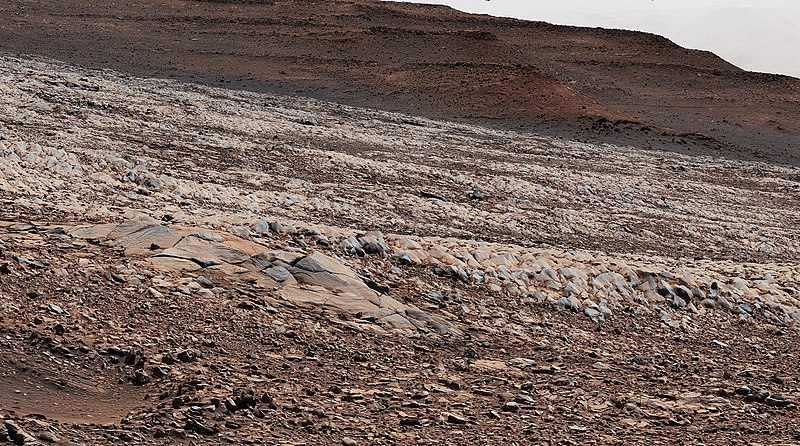File:PIA25175-MarsCuriosityRover-GatorBackRocks-Closeup-20220315.jpg

Original file (5,196 × 2,898 pixels, file size: 5.76 MB, MIME type: image/jpeg)
Captions
Captions
Summary
[edit]| DescriptionPIA25175-MarsCuriosityRover-GatorBackRocks-Closeup-20220315.jpg |
English: PIA25175: Curiosity Finds Gator-Back Rocks on Greenheugh
https://photojournal.jpl.nasa.gov/catalog/PIA25175 ALSO, see "Context" image at "File:PIA25176-MarsCuriosityRover-GatorBackRocks-20220323.jpg" NASA's Curiosity Mars rover used its Mast Camera, or Mastcam, to survey these wind-sharpened rocks, called ventifacts, on March 15, 2022, the 3,415th Martian day, or sol, of the mission. The team has informally described these patches of ventifacts as "gator-back" rocks because of their scaly appearance. Ventifacts chewed up Curiosity's wheels earlier in the mission. Since then, rover engineers have found ways to slow wheel wear, including a traction control algorithm. They also plan rover routes that avoid driving over such rocks, including these latest ventifacts, which are made of sandstone &ndsh; the hardest type of rock Curiosity has encountered on Mars. These rocks form the surface of the "Greenheugh Pediment," a broad, sloping plain in the foothills of Mount Sharp. The floor of Gale Crater is visible along the edges of the mosaic. When Curiosity's team saw the gator-back rocks, they ultimately decided to turn the rover around and take an alternative path to continue climbing Mount Sharp, a 3.4-mile-tall (5.5-kilometer-tall) mountain that Curiosity has been ascending since 2014. As it climbs, Curiosity is able to study different sedimentary layers shaped by water billions of years ago. These layers help scientists understand whether microscopic life could have survived in the ancient Martian environment. Curiosity was built by NASA's Jet Propulsion Laboratory in Southern California. Caltech in Pasadena, California, manages JPL for NASA. JPL manages Curiosity's mission for NASA's Science Mission Directorate in Washington. Malin Space Science Systems in San Diego built and operates Mastcam. For more about Curiosity, visit http://mars.nasa.gov/msl or https://www.nasa.gov/mission_pages/msl/index.html. |
| Date | |
| Source | https://photojournal.jpl.nasa.gov/jpeg/PIA25175.jpg |
| Author |
NASA/JPL-Caltech/MSSS " |
Licensing
[edit]This image or video was catalogued by Jet Propulsion Laboratory of the United States National Aeronautics and Space Administration (NASA) under Photo ID: PIA25175. This tag does not indicate the copyright status of the attached work. A normal copyright tag is still required. See Commons:Licensing. Other languages:
العربية ∙ беларуская (тарашкевіца) ∙ български ∙ català ∙ čeština ∙ dansk ∙ Deutsch ∙ English ∙ español ∙ فارسی ∙ français ∙ galego ∙ magyar ∙ հայերեն ∙ Bahasa Indonesia ∙ italiano ∙ 日本語 ∙ македонски ∙ മലയാളം ∙ Nederlands ∙ polski ∙ português ∙ русский ∙ sicilianu ∙ slovenščina ∙ Türkçe ∙ українська ∙ 简体中文 ∙ 繁體中文 ∙ +/− |
| Public domainPublic domainfalsefalse |
| This file is in the public domain in the United States because it was solely created by NASA. NASA copyright policy states that "NASA material is not protected by copyright unless noted". (See Template:PD-USGov, NASA copyright policy page or JPL Image Use Policy.) |  | |
 |
Warnings:
|
File history
Click on a date/time to view the file as it appeared at that time.
| Date/Time | Thumbnail | Dimensions | User | Comment | |
|---|---|---|---|---|---|
| current | 17:56, 9 April 2022 |  | 5,196 × 2,898 (5.76 MB) | Drbogdan (talk | contribs) | crop - seems better |
| 17:52, 9 April 2022 |  | 5,833 × 3,324 (5.05 MB) | Drbogdan (talk | contribs) | Uploaded a work by NASA/JPL-Caltech/MSSS from https://photojournal.jpl.nasa.gov/jpeg/PIA25175.jpg with UploadWizard |
You cannot overwrite this file.
File usage on Commons
There are no pages that use this file.